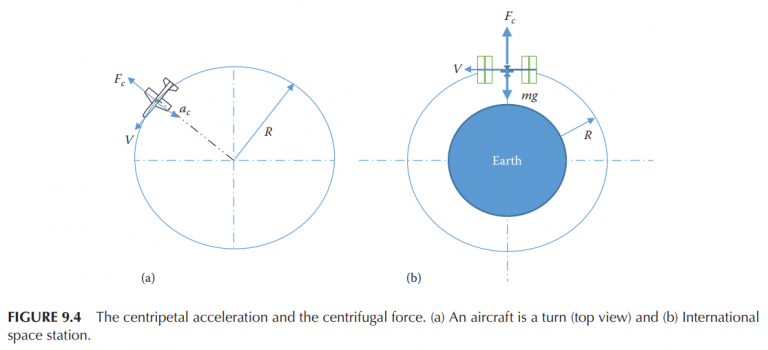Question 9.13: Determine the orbital velocity of a spacecraft at an altitud...
Determine the orbital velocity of a spacecraft at an altitude of 200 km from the earth if the weightlessness is desired. Assume the gravity is 9.8 m/s² at the height of 200 km and the earth’s radius is 6371 km. Then, compare this velocity with the speed of sound at the sea level (i.e., 340 m/s).
The blue check mark means that this solution has been answered and checked by an expert. This guarantees that the final answer is accurate.
Learn more on how we answer questions.
Learn more on how we answer questions.
g=\frac{V^2}{R}\Rightarrow 9.8=\frac{V^2}{200,000+6,371,000}\quad \quad \quad \quad (9.173)
The solution of this equation yields
V=8,025 m/s = 8.02 km/s = 28,889 km/h
This orbital velocity is 23.6 times the speed of sound at sea level.
(9.173): g=\frac{V^2}{R} where
m is the mass of the ISS or an astronaut
V is the linear velocity of the ISS or an astronaut
R is the radius of rotation (see Figure 9.4b)

Related Answered Questions
Question: 9.15
Verified Answer:
FAR does specify regulations/requirements for gust...
Question: 9.14
Verified Answer:
The airspeed of 440 knot is equivalent to 226.3 m/...
Question: 9.12
Verified Answer:
a. Load factor
n=\frac{V^2}{Rg}+1=\frac{(10...
Question: 9.11
Verified Answer:
We first need to find two parameters, namely, AR a...
Question: 9.10
Verified Answer:
We first need to find three parameters: K, AR, and...
Question: 9.9
Verified Answer:
We first need to find two parameters:
AR=\f...
Question: 9.8
Verified Answer:
From Example 9.6, m = 16,770 kg, S = 38 m², b = 12...
Question: 9.7
Verified Answer:
We first need to find two parameters:
AR=\f...
Question: 9.6
Verified Answer:
To investigate the capability of the aircraft for ...
Question: 9.5
Verified Answer:
We first need to find a few parameters:
\Bi...